Giving new life to classic TEK scopes and their plug-ins, 535, 547, 549 585A, 661,1S1, 1S2, etc
Over the years I have collected the older Tek scopes and plug ins. Down from fourteen to seven scopes now, but still find them incredibly useful. Being from the 60's, you now keep the finger on the switch and sniff for several minutes after turning on!. Those that use these old scopes with their fine traces and bulletproof front ends will know they still have a place. (Read "Vintage scopes are better" at readingjimwilliams.blogspot for an interesting dissertation)
Project: Restoring the classic Tektronix 1S2 plug in.
This 1960's sampling plug-in has a bandwidth of 3.5 gHZ, and useful to 5 gHZ, and is exceptionally useful in the matching of antennas. Notorious for tunnel diode failure which were impossible to obtain at any reasonable cost, if at all. A new life may be possible using the Russian tunnel diodes now appearing on the market. So, purchased a bucket load of all varieties, and my experience follows. Of the pictures below, one was a goer, one a smoker, and one totally stripped of tunnel diodes.
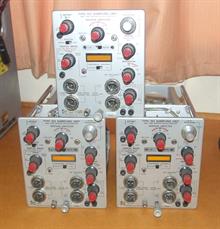
Project: Restoring the 133 power supply.
The 133 frame enables plug ins to be run outside of the normal oscilloscope. Intention is to run plug ins in this frame, use Arduino and serial all data to Excel, display and analyse it there.
Pictures show all electrolytics and paper capacitors replaced. Left shows a set of capacitors hung in space and original can in place. Right shows original can cut, and used to hold electros. It's very hard initially to accept these tiny electros can replace the huge original can models.
Pictures show all electrolytics and paper capacitors replaced. Left shows a set of capacitors hung in space and original can in place. Right shows original can cut, and used to hold electros. It's very hard initially to accept these tiny electros can replace the huge original can models.
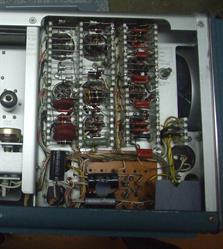
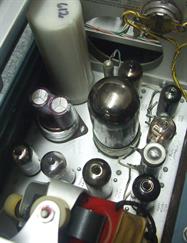
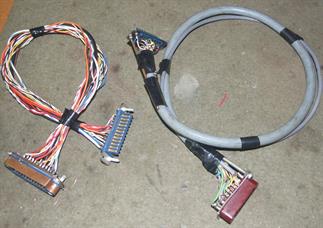
Tek collectors will understand
extensions are essential. Not as neat as the Tek item, but they do the job when servicing plug-ins. A Type 133
plug in power supply enables plug ins to run without an old scope fired up. Outputs are monitored on a modern scope.
extensions are essential. Not as neat as the Tek item, but they do the job when servicing plug-ins. A Type 133
plug in power supply enables plug ins to run without an old scope fired up. Outputs are monitored on a modern scope.
Project: TEK 549 Replace Horizontal amp transistors.Q554, Q564 with BD140's
Have had to replace several sets of these. An easy task, and recalibration was not needed .
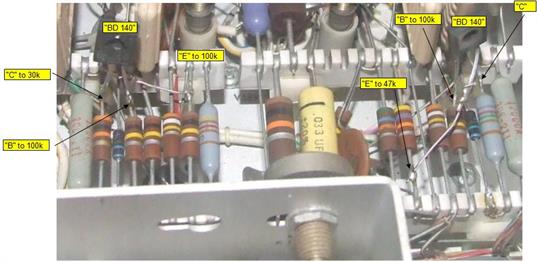
Project: Resistor calculation spreadsheet available in the ANTENNA BUILDERS COMPANION
In many places, TEK demands odd value resistors, not easy to obtain. This spreadsheet.enables you to calculate correct combinations to get a precision value. The material is contained within the RF workbooks, but this is a single workbook just for these calcs. My experience is that if the Tektronix circuit specifies a resistance of "9.01 kilohm" that is what you MUST have, and "near enough" is NOT good enough! Even with this calculator you mayhave to fiddle to get your value!
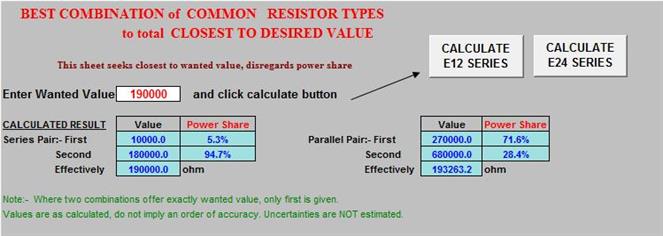
Left.Tektronix 1s2's, S/N 555, 588, & 761, now using Russian tunnel diodes, drop in replacements.
Electrolytic replacement, with new caps fitted to base of old can
Electrolytic replacement, new caps tucked in wherever they fit!
Above: Screenshot, EXCEL calculator for resistor combinations is in the ANTENNA BUILDER'S COMPANION
Project: Matching Tektronix Output ( +/- 10v ) to suit 0-5v Arduino ADC
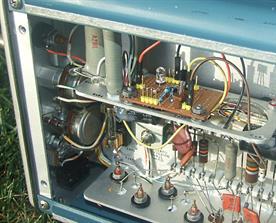
Above:- Small Bipolar to Unipolar converter board fits where the large electrolytics once sat
in the Tektronix 133 chassis
in the Tektronix 133 chassis
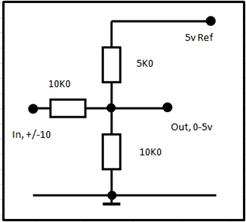
Above:- Pasive converter circuit to convert Tektronix 133 monitor output to 0 to 5v suit Arduino ADC
I order to use some old, specialised, Tek plug ins, the monitor outputs of +10v / -10v were incompatible with the 0-5v accepted by the Arduino Mega (3.3v for Arduino DUE). The bipolar to unipolar divider, and a 5v reference, was placed on a small board. Because I had replaced the old electros in my Tektronix 133 frame, the board was bolted in a free space created.
The simple resistive shifter did not exactly give the range calculated, mainly because the input measurement is not taken from a sufficiently low impedance source. I suggest you go the extra step and buffer input and output with op-amps. Use the Tek +/- 12v supply for the op-amp.
More importantly, whilst the manual suggests a +/-5 v across the low impedance output, the output from the monitor output comes perilously close to +/- 10v. Ensure a 5v clamp is on the line to your adc, and check outputs and calibration of your Tek device before attaching to a micro!
If using the 1S1, I found these are not very sensitive, and input has to be well above 'small signal' levels
The simple resistive shifter did not exactly give the range calculated, mainly because the input measurement is not taken from a sufficiently low impedance source. I suggest you go the extra step and buffer input and output with op-amps. Use the Tek +/- 12v supply for the op-amp.
More importantly, whilst the manual suggests a +/-5 v across the low impedance output, the output from the monitor output comes perilously close to +/- 10v. Ensure a 5v clamp is on the line to your adc, and check outputs and calibration of your Tek device before attaching to a micro!
If using the 1S1, I found these are not very sensitive, and input has to be well above 'small signal' levels
As Tektronix tunnel diode replacements are virtually impossible to get, I used Russian varieties to bring my Tektronix 1S2’s back to life. Every electrolytic capacitor was replaced first. Checked ceramics for shorts also, as I have been caught before.
Not having anything more sophisticated, I connected the old Goodwill CCT-1212A curve tracer (sold under many different names) and started with comparisons. Very simply, on this machine, 5mA types tunnel are tested at the 10v sweep setting,
10 mA types tunnel at 20v setting, and 20 mA types tunnel at 30v setting which makes it very simple to quickly identify the type to hand on this tracer.
Not having anything more sophisticated, I connected the old Goodwill CCT-1212A curve tracer (sold under many different names) and started with comparisons. Very simply, on this machine, 5mA types tunnel are tested at the 10v sweep setting,
10 mA types tunnel at 20v setting, and 20 mA types tunnel at 30v setting which makes it very simple to quickly identify the type to hand on this tracer.
Project: Russian Tunnel Diodes for Tektronix restorations.
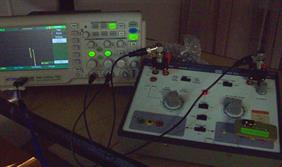
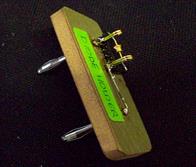
Using clips made of contacts
extracted from a mother-board socket, this adapter sits in the 1212A Diode Test sockets.
extracted from a mother-board socket, this adapter sits in the 1212A Diode Test sockets.
Goodwill tracer coupled to ADS1102CAL scope shows the important part of the curve. To see the "top half of the curve, change the type switch from PNP to NPN
I tested my 10 mA Russian diodes:- Types AU306Л, AU301G, 1U305Б, 3И306М,1U304A, 3И306K, AI201G, and AU306M. All these have a similar curved "shoulder", except for the 1U305Б and 1U304A which show sharp switching equal to the Tek originals
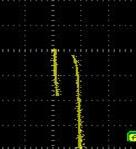
10mA Russian 1U305Б
"gold lead"
"gold lead"
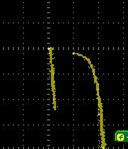
10mA Russian AU301Г
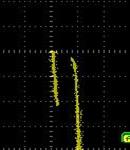
10mA ,ex GR Counter

10mA Tek, bead style, TD253
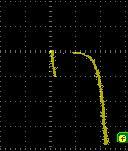
5mA Russian 3N306K
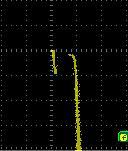
5mA Tek 1N3716
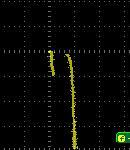
5mA Russian 1U304A
"gold lead"
"gold lead"
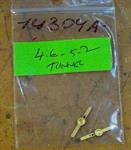
Only the “gold lead” series have curves closely resembling Tek 5 & 10 mA diodes.
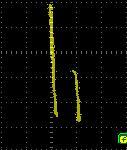
10mA ,ex GR Counter again, using Octopus Tester (see my “CURRENT” page for details) Does a similar job, but the voltage ranges on mine do not let you immediately detect what mA type your diodes are.
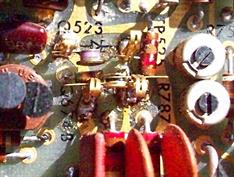
To make rapid substitutions possible, clips were added to take the diodes on a temporary basis. Above left is Chassis 555, with Russian 0.1 mA Back Diode and 1U305Б Tunnel Diode in place. Right, Chassis 761, D544 replaced with a Russian AU301Г
Diodes were inserted using grounded tweezers.
Diodes were inserted using grounded tweezers.
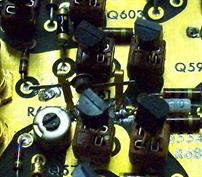
So far three 1S2’s have had their trigger circuit D525 and D544, 10 mA types replaced. All three plug ins are now basically functional, all need cal.
Chassis 761: D544 replaced by AU301Г, D525 replaced by AU301Г. Waveforms per manual obtained.
PA4TIM’s 1S2 cal notes mentioned the difficulty some scopes had in triggering to get the D525 waveform. I agree!
Chassis 588: D544 replaced by 1U305Б, D525 replaced by 1U305Б. Waveforms on TP544 reasonable approximation, but I had no effective scope triggering on D525. Adjustment on TP544 very touchy. May go back to AU301Г
Chassis 555: D524 replaced by Russian 0.1mA Back Diode. Curve identical to Tek 0.1mA
D544 replaced by AI301G, D525 replaced by AI301G. Waveforms, almost per manual obtained.
D675 replaced by 1N304A, Russian 4.6-5.2 mA
These notes indicate successful substitutions, but there will be places, eg. memory gate and sampler, where the diodes will have to be more exact substitutes.
Chassis 761: D544 replaced by AU301Г, D525 replaced by AU301Г. Waveforms per manual obtained.
PA4TIM’s 1S2 cal notes mentioned the difficulty some scopes had in triggering to get the D525 waveform. I agree!
Chassis 588: D544 replaced by 1U305Б, D525 replaced by 1U305Б. Waveforms on TP544 reasonable approximation, but I had no effective scope triggering on D525. Adjustment on TP544 very touchy. May go back to AU301Г
Chassis 555: D524 replaced by Russian 0.1mA Back Diode. Curve identical to Tek 0.1mA
D544 replaced by AI301G, D525 replaced by AI301G. Waveforms, almost per manual obtained.
D675 replaced by 1N304A, Russian 4.6-5.2 mA
These notes indicate successful substitutions, but there will be places, eg. memory gate and sampler, where the diodes will have to be more exact substitutes.